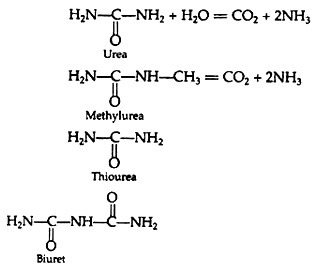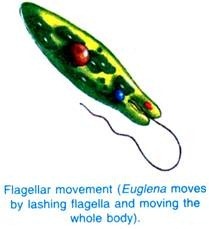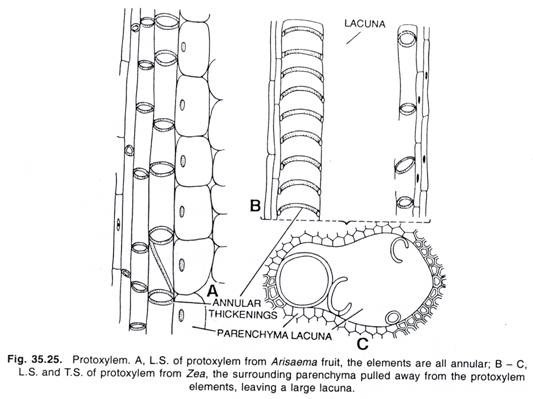ADVERTISEMENTS:
In most instances, the association of the enzyme with the substrate is so fleeting that the complex is extremely difficult to detect.
Yet, as early as 1913, L. Michaelis and M. L. Menten postulated the existence of this transient complex.
On the basis of their observations with the enzyme invertase, which catalyzes the hydrolysis of sucrose to glucose and fructose, they proposed that enzyme-catalyzed reactions were characterized by a sequence of phases that involves:
ADVERTISEMENTS:
(1) The formation of a complex (ES) between the enzyme (E) and the substrate (S);
(2) The modification of the substrate to form the product (P) or products, which briefly remain associated with the enzyme (EP); and
(3) The release of the product or products from the enzyme; that is,
In this equation, it is assumed that the combination of enzyme and substrate is reversible; is the rate constant for the formation of ES (the dimensions of the rate constant are seconds-1), and k2 is the rate constant for the dissociation of ES. After the ES complex is formed, S is converted to P with the rate constant k3. As long as the concentration of P remains negligible (as it would be at the outset of catalysis) or if P is in some manner quickly removed from the system, then it is not necessary to consider the negligible reverse flux from E + P to ES.
ADVERTISEMENTS:
Figure 8-4 depicts the relationship that exists between substrate concentration and the rate at which reaction products appear for enzyme-catalyzed reactions of this type. The curve describes the initial rate of product formation at a fixed enzyme concentration when the substrate concentration is varied on successive trials.
At low concentrations of substrate, the initial velocity of the reaction (i.e., v0) is directly proportional to the substrate concentration (i.e., follows first-order kinetics). However, as the substrate concentration is increased, the reaction velocity levels off, approaching a maximum value.
At this high substrate concentration, the reaction velocity is limited by the amount of time required to convert bound substrate (i.e., ES) to product (P) and free enzyme (E). The curve now follows zero-order kinetics. The curve of Figure 8-4 is called a Michaelis-Menten curve, and for an idealized enzyme-catalyzed reaction is a rectangular hyperbola.
Michaelis and Menten are also credited with the first mathematical study of the relationship between substrate concentration and reaction rates. They introduced two particularly useful mathematical expressions that for any enzyme relate [S] to V (velocity) and permit quick comparisons of various enzyme- catalyzed reactions; the two expressions are now called the Michaelis-Menten constant and the Michaelis-Menten equation. They are derived as follows.
Let
[S] = the concentration of free substrate, S; (We may assume that the amount of available substrate is so great that the amount combined with the enzyme may be ignored in comparison. Hence, total substrate concentration and the free substrate concentration are the same);
[E]T =the total concentration of enzyme, E;
ADVERTISEMENTS:
[E] = the concentration of free enzyme (that not complexed with substrate);
[ES] = the concentration of enzyme-substrate complex (Because the total amount of enzyme present is assumed to be very small in comparison with the total amount of substrate, a significant proportion of the total enzyme may be involved in the ES complex. Hence, separate terms for the total and free enzyme concentrations are warranted);
[P] = the concentration of product, P.
The total enzyme concentration is given by:
The ratio of constants given in equation 8-22 may be set equal to a new constant, KM, which is the Michaelis-Menten constant. Thus, the Michaelis- Menten constant is a constant that relates the steady- state concentrations of enzyme, enzyme-substrate complex, and substrate.
Each enzyme-catalyzed reaction reveals a characteristic KM value, and this value is a measure of the tendency of the enzyme and the substrate to combine with each other. In this sense, the KM value is an index of the affinity of the enzyme for its particular substrate.
Some representative KM values are given in Table 8-2. It is to be stressed that the greater the affinity of an enzyme for its substrate, the lower the KM value. This is because the KM value is numerically equal to the substrate concentration at which half of the enzyme molecules are associated with substrate (i.e., in the ES form).
The relationships derived above are based on reactions in which a single substrate molecule is bound to the enzyme. However, they also apply in situations where more than one substrate is bound to the enzyme, as long as the concentrations of all but one substrate species are held constant or are not rate- limiting (i.e., present in large excess).
ADVERTISEMENTS:
For example, even the pioneering studies of Michaelis and Menten involved a bimolecular enzyme-catalyzed reaction. They employed the enzyme invertase, which forms a complex with one molecule of sucrose and one molecule of water and releases glucose and fructose as products. However, in this reaction (as in nearly all hydropses), the concentration of water remains virtually unaltered during the course of the reaction.
Ku values are seldom determined using the relationship given in equation 8-22, because the enzyme- substrate concentration [ES] cannot easily be measured. Some additional mathematical manipulations may be carried out to convert equation 8-22 into a more useful form.
As seen in Figure 8-4, the initial reaction velocity increases with substrate concentration until the enzyme concentration becomes limiting, and at that time, the initial reaction velocity approaches a maximum value (i.e., Vmax). This occurs because nearly all the enzyme is maintained in the ES form. Thus, [ES] will equal [E]T, and k3[E]T corresponds to Vmax.
By substituting Vmax for k3[E]T in equation 8-27, we obtain
Equation 8-28 is the Michaelis-Menten equation. From this equation, it may be seen that when the substrate concentration is numerically equal to the KM value of the enzyme, then the reaction velocity is equal to one-half the maximum value. For example, if [S] and Km are both equal to 3, then equation 8-27 simplifies to
Consequently, the Michaelis-Menten constant for an enzyme may be determined from the substrate concentration at which the reaction velocity proceeds at one-half its maximum value (Fig. 8-5).
From the above, we may conclude that the maximum velocity of an enzyme-catalyzed reaction depends on the affinity between the enzyme and its substrate (i.e., the KM value). The higher the KM value is, the lower the affinity of the enzyme for the substrate; and the smaller the KM value, the greater the affinity.
In many instances, the same substrate may enter either of several different enzyme-catalyzed reactions occurring in cells. Which of the alternative reactions predominates in the cell depends in part on the KM values of the respective enzymes and the concentration of available substrate.
At very low substrate concentrations, the specific reaction catalyzed by the enzyme with the lowest KM will dominate, whereas at higher substrate concentrations, the reaction catalyzed by the enzyme having the greatest KM value can dominate (if enough of the enzyme is present).
Therefore, which of several different metabolic pathways is actually followed by the initial substrate in the course of a series of enzyme-catalyzed reactions may be regulated by controlling the amount of available substrate. The relationship between reaction velocity and substrate concentration for two enzymes that act on the same substrate is depicted in Figure 8-6.
To obtain the KM value of an enzyme experimentally, it is necessary to determine v0 for a series of substrate concentrations. In practice the evaluation of KM from a plot similar to that in Figure 8-6 is difficult, because the precise value of Vmax cannot be determined. This is because the curve is a rectangular hyperbola that approaches Vmax asymptotically. In 1934, H. Lineweaver and D. Burk introduced a different form of the Michaelis-Menten equation (8-28) that simplifies the determination of KM from experimentally obtained values of [S] and v0. In this form, the acquired data are used to construct a straight line rather than a hyperbola. By taking the inverse of equation 8- 28 we obtain
The terms are now arranged in the form of the general equation of a straight line, y = ax + b, in which a is the slope of the line and b is the intercept on the y axis. Thus, for equation 8-31, 1/v0 serves as the y axis and 1/[S] as the x axis. Consequently, the y intercept will be 1/vmax, the slope will be KM/Vmax, and the x intercept will be -1/KM. The graph showing this relationship (known as a double reciprocal plot) is presented in Figure 8-7.![Lineweaver-Burk double reciprocal plot of 1/V0 and 1/[s] can be used to construct a line may easily be extrapolated backward to find the km value for the enzyme Lineweaver-Burk double reciprocal plot of 1/V0 and 1/[s] can be used to construct a line may easily be extrapolated backward to find the km value for the enzyme](https://www.biologydiscussion.com/wp-content/uploads/2014/09/clip_image022_thumb4.jpg)










